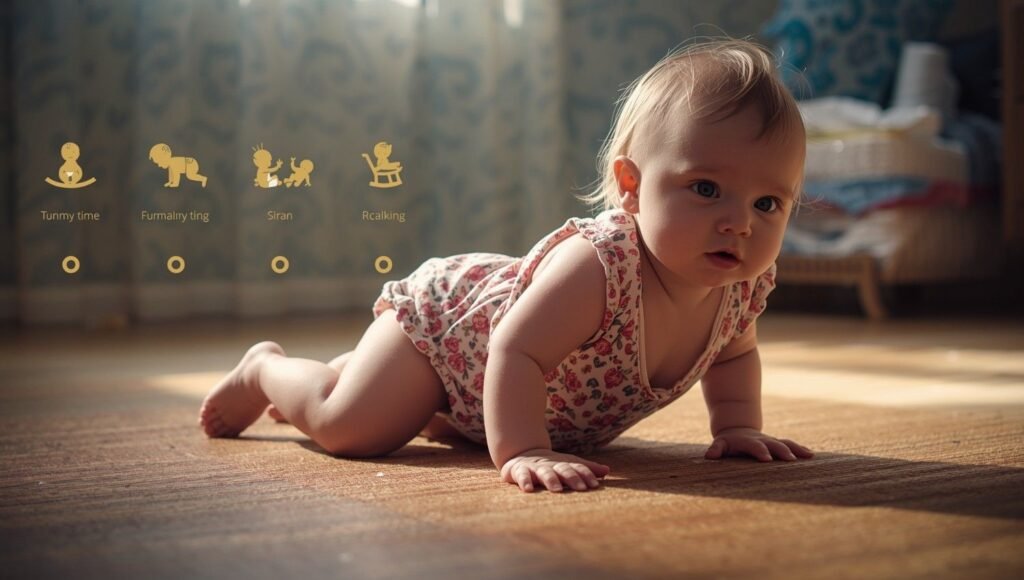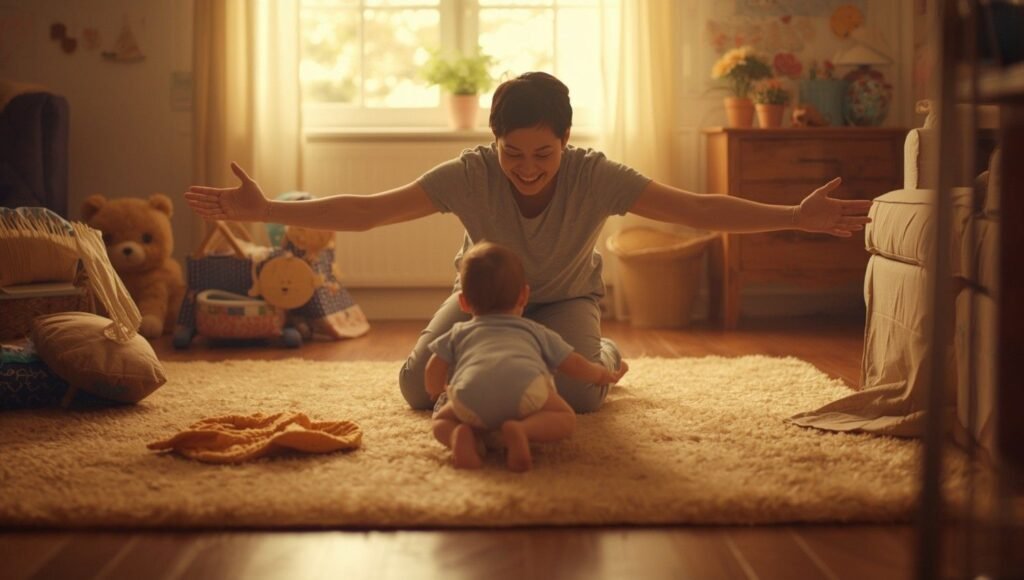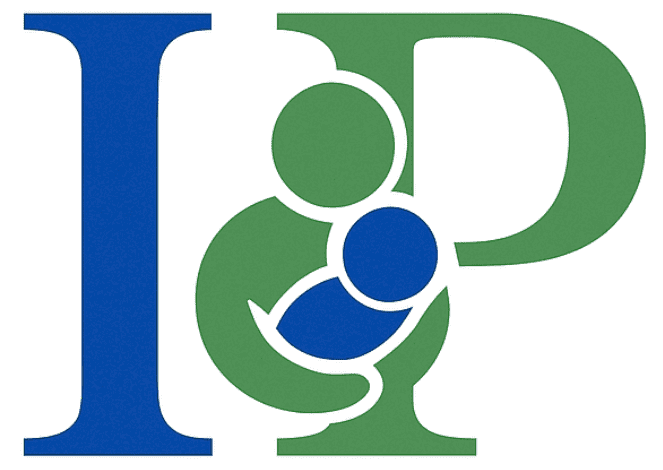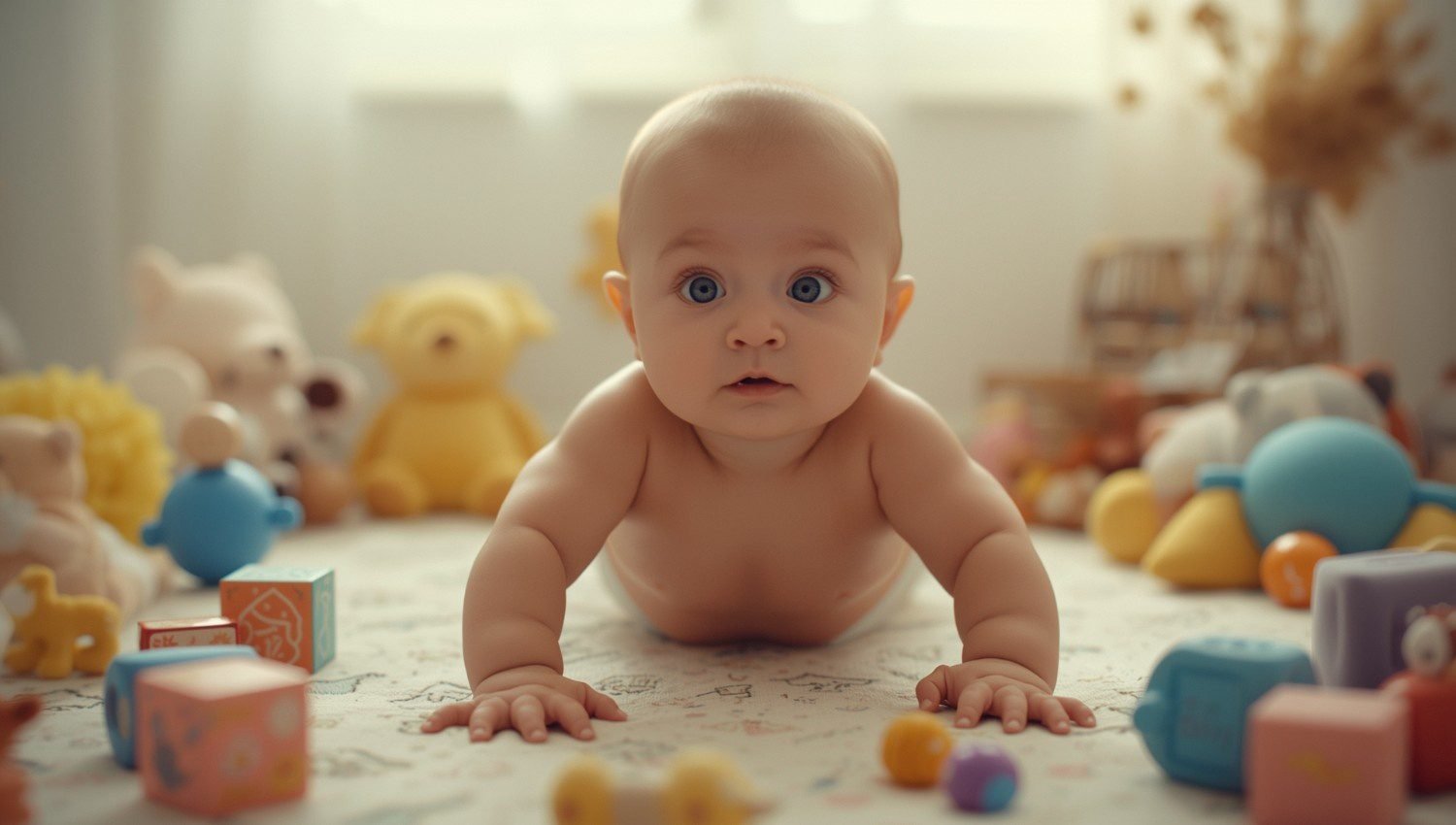Baby Milestones: When Babies Sit Up, Roll Over, and Crawl
Watching your baby grow is one of the most exciting experiences as a parent. From the first smile to the first laughs, and yes, even the first diaper blowout, there are so many firsts to celebrate. One of the most exciting developmental milestones your baby will conquer is crawling. Babies typically start to crawl between 6 to 10 months, but some may start earlier or later. It’s a part of their development that reflects a growing sense of independent mobility. As babies begin to crawl, they gain more freedom, and the world around them becomes much more accessible. Of course, this newfound freedom also comes with safety concerns, so it’s important to ensure they’re in a safe environment where they can explore without risk. Babies will develop at their unique style, some moving in a commando-type crawl or rocking on their hands and knees before taking off.
Tracking your baby’s progress during the first few years is essential as they grow and change quickly. Every day, your baby is learning and mastering new motor skills. Watching your little one learn to sit up, roll over, and crawl is an incredible journey. At about 2 months, they start to develop the upper body and neck muscles needed to hold their head steady. By 4 months, they begin to push up on their stomach, getting closer to the foundation of crawling. At 6 months, you may see them begin to rock from side to side, a sign they’re getting ready to move forward. By 9 months, they often start to crawl—sometimes even moving backward before they move forward. As they reach for their favorite toys, it encourages movement and helps with physical development. You’ll want to keep their environment childproof, moving any dangerous items like cleaning products or safety gates around stairs. By 12 months, your baby could be fully mobile, excited to discover their surroundings. So keep an eye out for those early signs that your baby is ready to explore on their own.

When should I expect my baby to crawl?
As a parent, it’s exciting to track your baby’s developmental milestones, and one of the most awaited is when they crawl. Generally, babies begin this motor skill between 6 to 10 months, but it varies from child to child. You might notice your baby starting with rolling over, followed by pushing up on their hands, and eventually moving on their stomach. Each baby has their unique style—some babies sit up first, and others may move backwards before they go forward. These firsts can be a little surprising, but they’re all part of their rapid development.
Don’t be surprised if you don’t see a perfect, textbook crawl immediately. Some babies take their time to develop independent mobility, and that’s okay. Just like the way they mastered smiles, laughs, and even a diaper blowout, your baby’s journey to crawling will unfold in its own time. They’re constantly discovering and exploring their environment, so keep an eye out for physical signs like pushing up on their arms or trying to move by rocking back and forth on their hands and knees. These are signs that your baby is ready to learn this new skill.
Crawling and Sleep
When your baby starts to crawl, it’s an exciting milestone that comes with its own set of challenges, including changes in sleep patterns. Babies often experience sleep regression around 8 or 9 months, a period when their bodies are going through so much physical growth and development. As they learn to crawl, they may feel more energetic and want to explore, even during their usual sleep time. It’s not uncommon for babies to resist resting in their cribs as they become more active and curious about their surroundings.
During this phase, it’s important to allow your baby to practice crawling during the day, but also ensure they have a calm and consistent bedtime routine. As they gain more independence and learn to move, it’s normal for them to spend more time awake and moving, sometimes even closing their eyes later than usual. This change in behavior can be tough, but it’s a part of the rapid development your baby is experiencing as they approach the next big milestone. Managing these changes with a balance of play and rest will help them adjust better to this new phase.
Different Stages of Crawling
Babies go through multiple stages before they fully crawl. They might skip stages or do things out of order, but this is normal. Early on, your baby may start by spending time in tummy time. This helps with strengthening their head, neck, and back muscles, preparing them for the big steps ahead. As your baby reaches about 6-10 months, you might notice them trying to push up from their belly or rocking while on their hands and knees—signs that they are getting ready to move! The American Academy of Pediatrics (AAP) recommends giving babies about 30 minutes of tummy time each day to help build the muscles they’ll need for crawling. Some babies may even pivot, making small circles while on their belly, or plank, lifting up their belly and moving onto hands and knees as they practice balance.
- Tummy Time
Tummy time is essential for babies as it helps strengthen their muscles, including those in their head, neck, and back. The AAP suggests doing tummy time for 3 to 5 minutes several times a day to prevent flat heads and promote healthy motor development. As babies push up and hold their arms, they gradually develop the strength needed to transition from lying on their bellies to moving forward. It’s a good idea to supervise them during this time to ensure they’re comfortable and safe, especially in the early days. Babies who enjoy playful activities during tummy time, like reaching for a toy, will be more likely to progress to hands and knees and eventually start crawling.
- Pivoting
As babies grow stronger, they begin to explore locomotion with their belly and head. Around 5 to 7 months, many babies start pivoting, which is when they move their belly in small circles while on their stomach. This action helps them build neck muscles and learn to move their body in different directions. The first taste of movement may excite them as they push up and shift their weight from side to side. It’s a critical step that sets the stage for future crawling!
- Planking
After babies gain some strength in their neck and head, they may begin planking. This is when they rise up into a plank position, lifting their bellies off the floor and balancing on their hands and toes. This is a hands-and-knees position, a clear sign that they are getting ready to crawl. Planking helps babies develop better balance and prepares them for the transition into full crawling, using their arms and legs to propel themselves forward.
- Moving Forward on Belly
As babies become more accustomed to locomotion, they begin to move forward on their bellies. This stage is marked by them scooting or jumping forward in small steps. They might push themselves with their hands or legs, often ending up in a belly position after each movement. This is the precursor to getting onto their hands and knees and is an exciting phase as babies explore the world around them.
- Rocking on Hands and Knees
When babies transition into the hands-and-knees position, they start rocking back and forth. This is their way of balancing on all fours, preparing to move forward or backward. At this stage, babies are testing their coordination and learning how to shift their weight. As they rock, they’ll begin to understand how to move each arm and leg independently, eventually leading to their first crawling steps.
- Moving from Belly to Sitting Up
Once babies become more comfortable with locomotion, they’ll learn to transition from their belly to sitting up. This is an important milestone where they strengthen their core muscles and learn to balance while sitting. Some babies crawl directly into this position, while others may push backward or sit up independently, using their arms to support themselves. This marks an important step in their physical development and prepares them for more complex movements.
- Pushing Backward
Before babies start moving forward, they might first try pushing backward. Using their arms to propel themselves, babies may end up moving backward on their belly or hands and knees. While this can be frustrating for parents, it’s a valuable stage where babies develop motor control and coordination. It’s a necessary step that helps them understand how to control their movements and eventually move forward.

Are There Different Types of Crawls?
As babies grow, their crawling style may not always follow the same pattern. While most babies eventually move with the classic crawl—on their hands and knees—other babies might try different methods to get around. Some may use the commando crawl, moving their tummy down with their forearms and elbows, almost like an army crawl. Others could attempt a bear crawl, using their arms and legs while standing upright and shifting forward. You may also see babies try the crab crawl, which involves both arms and knees, moving sideways or backward. These types of crawls can be surprisingly varied and unique as babies explore their environment and develop new ways to move.
Classic Crawl
The classic crawl is the most common style where babies use hands and knees in a reciprocal pattern. This means the baby moves one hand and the opposite knee forward at the same time, creating a natural forward motion. Over time, this crawl becomes smoother as babies gain strength and balance. This method is often a key step in the process, marking the baby’s transition to more independent movement.
Belly Crawl
Before babies master the classic crawl, many start with the belly crawl, also known as the commando crawl. In this style, babies stay in a belly position, using their arms to pull forward. They may also use a plank position to lift their belly off the floor and move in an inchworm crawl motion. It’s their first taste of locomotion and helps them strengthen their core muscles for the eventual classic crawl.
Bear Crawl
The bear crawl is another style where babies move with their hands and feet outstretched, somewhat like an animal on all fours. This crawling style helps babies strengthen their arms and legs while beginning to get a feel for forward movement in a more upright position. It’s a fun and playful way for babies to develop strength and coordination.
Rolling Crawl
Some babies may even resort to a rolling crawl, where they maneuver by rolling from point A to point B. This type of movement can seem dizzying, but it’s part of their natural exploration as they work on their physical development. While it may not be the most efficient way to get around, it’s still a sign that your baby is becoming more aware of how to move their body and interact with the world.
Bottom Scoot Crawl
The bottom scoot crawl is a cute style that involves the baby sitting upright and using their arms to scoot around, dragging their bottom across the floor. They may move in different directions, pushing with their legs to help them navigate. It’s a simple but effective way for babies to move short distances before transitioning to more advanced crawling styles.
Crab Crawl
The crab crawl is another creative way babies move, often propelling themselves using both arms and knees. In this style, babies may shift sideways, using their knee and foot to push while their hands work to balance them. It’s another unique style that shows how babies develop their own way of crawling as they continue to explore their environment.

What can I do to help my baby crawl?
To help your baby start crawling, the key is to encourage their physical development by providing a safe, stimulating environment. Make sure to give your little one plenty of tummy time early on—this will strengthen their head, neck, back, and leg muscles, all of which are essential for crawling. A daily play routine is important to build their motor development and keep things fun. Use a mat indoors or a blanket outdoors for a soft and safe place for them to explore.
Supervise your baby closely and watch for any potential safety concerns. You can place toys or objects just out of reach to encourage your baby to stretch and reach across their midline. Use a picture book or an exciting toy to catch their attention. Be sure to create a safe space by removing small objects, cords, or anything that could pose a choking hazard. When encouraging your baby, use an excited tone of voice, praise, and positive facial expressions to boost their confidence. These small actions will help your baby grow stronger and more capable as they prepare for their next milestone: crawling!

Tips and Tricks to Encourage Your Baby to Crawl
If you’re wondering how to help your baby with crawling, there are several tips and tricks you can try. Start by giving your baby plenty of tummy time—this is essential for developing the muscles they need for crawling. You can also teach your baby by offering support when they’re in the tummy position, gently helping them stretch their arms and legs. Encouraging them to move by using their favorite toys and creating a safe environment will also boost their confidence. Try engaging your baby with a smile and excitement, making it fun for them to move.
Place Toys Up High Temporarily
One of the most effective tricks to encourage crawling is to place a favorite toy just out of reach. Put it up high on a chair or couch, where your baby will need to lift their head, push up, and eventually move their hands and knees to find the toy. This is an excellent way to practice the motion of crawling, and it encourages your baby to use their arms and legs in a coordinated way to reach the toy. It’s a simple exercise that makes crawling fun and rewarding.
Offer Some Support
During tummy time, try offering support to help your baby find their balance. You can gently place your hand on their chest or legs to encourage them to push up and strengthen their arms. Gradually, as they grow more confident, you can help them move into a sitting position, where they can practice stretching and keeping their back straight. This support helps your baby’s motor development and sets them up for the next big step towards crawling.
Do Push-ups Together
Another fun way to get your baby excited about crawling is by doing push-ups together. You can rock on the ground, facing your baby, and encourage them to copy you as you do a full push-up. Babies love mimicking, especially when they see you having fun, so this can motivate them to strengthen their arms and legs. It’s a great way to help your baby develop the muscles needed to eventually crawl.
Rock to Music
Sometimes, a little rhythm can help babies get moving. Rocking to music while on their hands and knees can help babies practice forward and backward motions. You can mimic the movements, encouraging them to copy and move to the beat. It’s a fun way to engage with your baby while helping them improve their balance and coordination, two key skills needed for crawling.
Crawl to a Favorite Toy
Babies love surprises, so use that to your advantage! Place a favorite toy a little further away than usual and encourage your baby to crawl toward it. The toy will motivate them to use their hands and knees to move forward, and the excitement of reaching it will give them the extra push they need to start crawling. It’s a great way to combine play and physical activity in a way that feels like a fun game.
Dress for the Occasion
What your baby wears can actually make a big difference in their crawling ability. Avoid slippery clothing like tights or socks on hard surfaces, as it may cause them to slide backward instead of moving forward. Opt for pants or leggings that provide some traction to their knees and toes. This way, they’ll have a better grip on the floor and be able to push themselves forward with more ease, making it easier to practice crawling.
When to Worry About Baby Not Crawling: When to Call the Doctor?
It’s exciting when your baby starts to crawl, but if they seem to be skipping milestones, it’s important for parents to pay attention. Most babies start to move around 6 to 10 months, but it’s normal for some to take a little longer. If your baby seems to be struggling with muscles or balance and is not showing interest in exploring or crawling on the ground, it could be a sign that they need extra help. In cultures around the world, babies start crawling at different ages, and some may even skip the crawling phase entirely and go straight to standing upright and walking. However, if your baby hasn’t started moving or showing any signs of crawling by 12 months, it’s a good idea to consult your healthcare provider. Early evaluation by clinicians can help identify any developmental issues and ensure there are no negative sequelae or delays. If necessary, they may recommend early intervention to support your baby’s motor skills.
If your baby isn’t interested in moving or isn’t developing balance or muscle strength to crawl, it’s a good idea to call the doctor. It’s better to be cautious, especially if your baby is not meeting other developmental milestones like sitting up or showing curiosity in their environment. A quick visit to the doctor or healthcare provider could provide reassurance or an opportunity to address any concerns early. In the United States, doctors may offer a referral for further evaluation if needed. But don’t panic—many babies reach milestones at their own pace. Just make sure your baby is safe and getting the support they need to grow and develop.
FAQ
When Do Babies Start Crawling?
The typical age for babies to start crawling is between 6 to 10 months. However, some babies may start earlier or later. Keep in mind that each child is different, and some may skip crawling altogether and go straight to walking.
What Is the Crawling Age Range?
Babies generally begin crawling between 6 and 12 months of age. However, this can vary depending on factors such as physical development, motor skills, and individual readiness. It’s essential to encourage your baby with tummy time and plenty of space to explore and build strength.
Why Is My Baby Not Starting to Crawl Yet?
If your baby isn’t crawling by 9 to 12 months, it might simply be that they are developing at their own pace. Some babies may prefer other forms of movement, like rolling over or scooting. If you’re concerned, make sure to provide opportunities for tummy time, physical activity, and encourage exploration. If you’re unsure, always consult your pediatrician.
Is Delayed Crawling in Babies Normal?
Many parents wonder if delayed crawling in babies is a cause for concern. While most babies start crawling between 6 and 10 months, it’s important to remember that each baby develops at their own pace. Some may begin crawling a bit later without it being a sign of a problem. However, if you’re concerned about your baby’s development, it’s always a good idea to consult with your pediatrician.
Do Some Babies Skip Crawling?
Yes, some babies skip crawling altogether. Instead, they may go straight to pulling up, standing, and walking. Skipping crawling is usually not a concern, but it’s important to ensure that your baby has plenty of opportunities to strengthen their muscles through activities like tummy time.
What Are the Signs of Baby Crawling?
Signs that your baby may be getting ready to crawl include rocking back and forth on their hands and knees, pushing up from their tummy, or starting to move in a “commando crawl” style by dragging themselves forward. As they grow stronger, you’ll notice increased arm and leg strength, helping them transition into full crawling.

